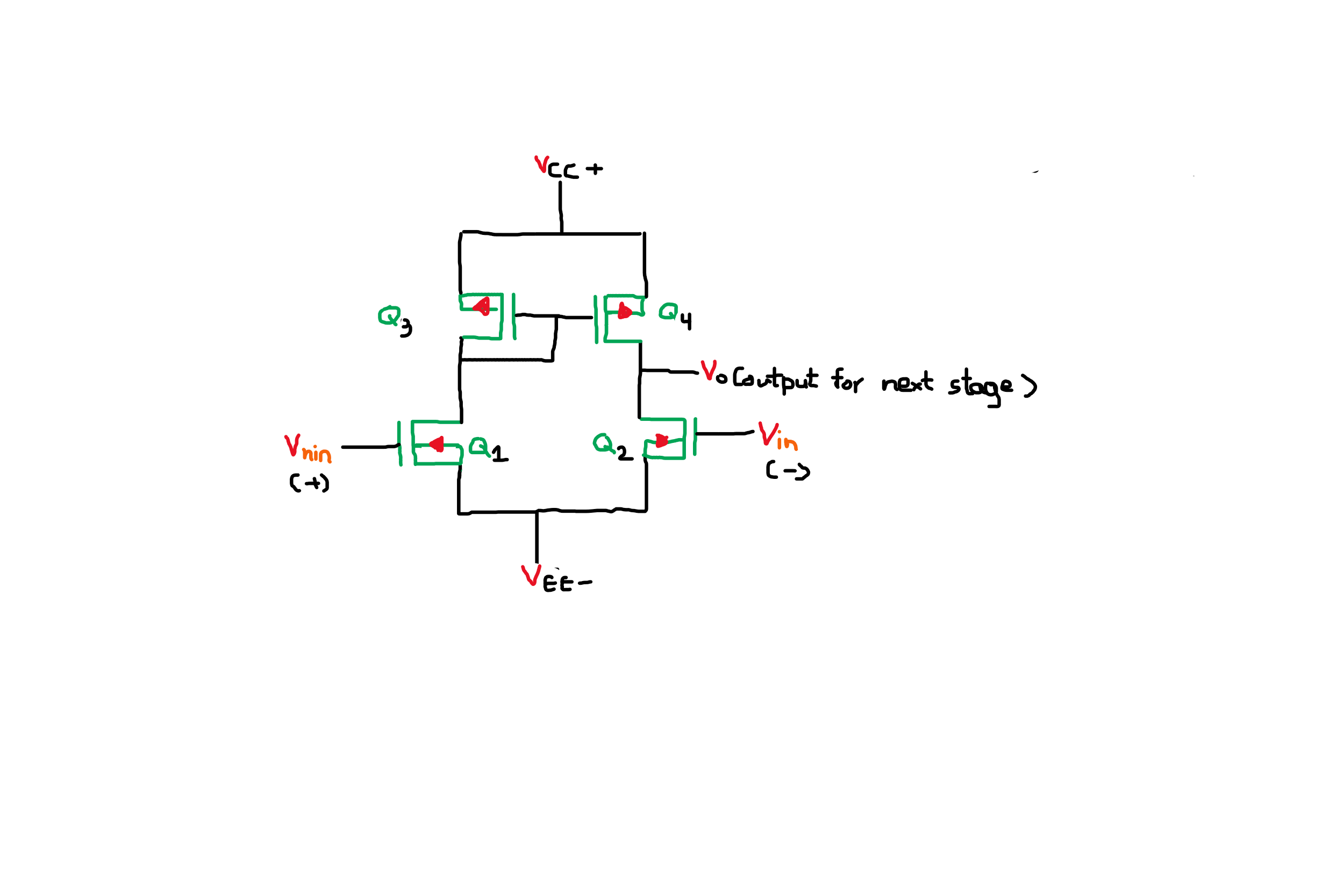Post History
How does the differential to single ended converter work? In order for the circuit to work, Q1 and Q3 must be in the saturation region and depending on the voltage inputs, one of Q2 and Q4 will be...
#4: Post edited
MOSFET differential to single ended converter intuition
How does the differential to single ended converter work?In order for the circuit to work Q1 and Q3 must be in saturation region and depending on the voltage inputs one of Q2 and Q4 will be in ohmic region and one will be in the saturation region.I understand that IQ1 is copied to(from Q3) IQ4 but if Q4 is in the ohmic region it acts like a voltage controlled resistor so I don't get that current adding.- 
- I understand its disadvantage is low gain while its advantage is it is more 'precise' than the BJT equivalent.
- How does the differential to single ended converter work?
- In order for the circuit to work, Q1 and Q3 must be in the saturation region and depending on the voltage inputs, one of Q2 and Q4 will be in the ohmic region and one will be in the saturation region.
- I understand that IQ1 is copied to (from Q3) IQ4, but if Q4 is in the ohmic region it acts like a voltage-controlled resistor, so I don't get that current adding.
- 
- I understand its disadvantage is low gain while its advantage is it is more 'precise' than the BJT equivalent.
#3: Post edited
- How does the differential to single ended converter work?In order for the circuit to work Q1 and Q3 must be in saturation region and depending on the voltage inputs one of Q2 and Q4 will be in ohmic region and one will be in the saturation region.I understand that IQ1 is copied to(from Q3) IQ4 but if Q4 is in the ohmic region it acts like a voltage controlled resistor so I don't get that current adding.
- I understand its disadvantage is low gain while its advantage is it is more 'precise' than the BJT equivalent.
- How does the differential to single ended converter work?In order for the circuit to work Q1 and Q3 must be in saturation region and depending on the voltage inputs one of Q2 and Q4 will be in ohmic region and one will be in the saturation region.I understand that IQ1 is copied to(from Q3) IQ4 but if Q4 is in the ohmic region it acts like a voltage controlled resistor so I don't get that current adding.
- 
- I understand its disadvantage is low gain while its advantage is it is more 'precise' than the BJT equivalent.
#2: Post edited
- How does the differential to single ended converter work?In order for the circuit to work Q1 and Q3 must be in saturation region and depending on the voltage inputs one of Q2 and Q4 will be in ohmic region and one will be in the saturation region.I understand that IQ1 is copied to(from Q3) IQ4 but if Q4 is in the ohmic region it acts like a voltage controlled resistor so I don't get that current adding.
- I understand its disadvantage is low gain while its advantage is it is more 'precise' than the BJT equivalent.
- How does the differential to single ended converter work?In order for the circuit to work Q1 and Q3 must be in saturation region and depending on the voltage inputs one of Q2 and Q4 will be in ohmic region and one will be in the saturation region.I understand that IQ1 is copied to(from Q3) IQ4 but if Q4 is in the ohmic region it acts like a voltage controlled resistor so I don't get that current adding.
- 
- I understand its disadvantage is low gain while its advantage is it is more 'precise' than the BJT equivalent.
#1: Initial revision
MOSFET differential to single ended converter intuition
How does the differential to single ended converter work?In order for the circuit to work Q1 and Q3 must be in saturation region and depending on the voltage inputs one of Q2 and Q4 will be in ohmic region and one will be in the saturation region.I understand that IQ1 is copied to(from Q3) IQ4 but if Q4 is in the ohmic region it acts like a voltage controlled resistor so I don't get that current adding.  I understand its disadvantage is low gain while its advantage is it is more 'precise' than the BJT equivalent.


















